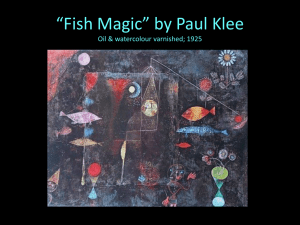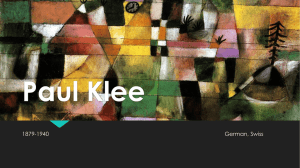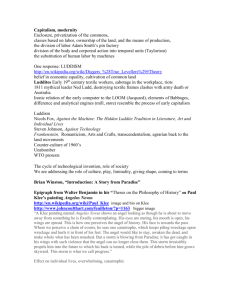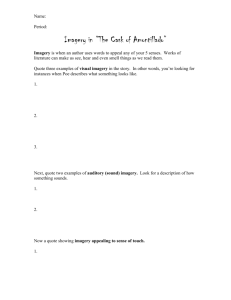- Radford University
advertisement
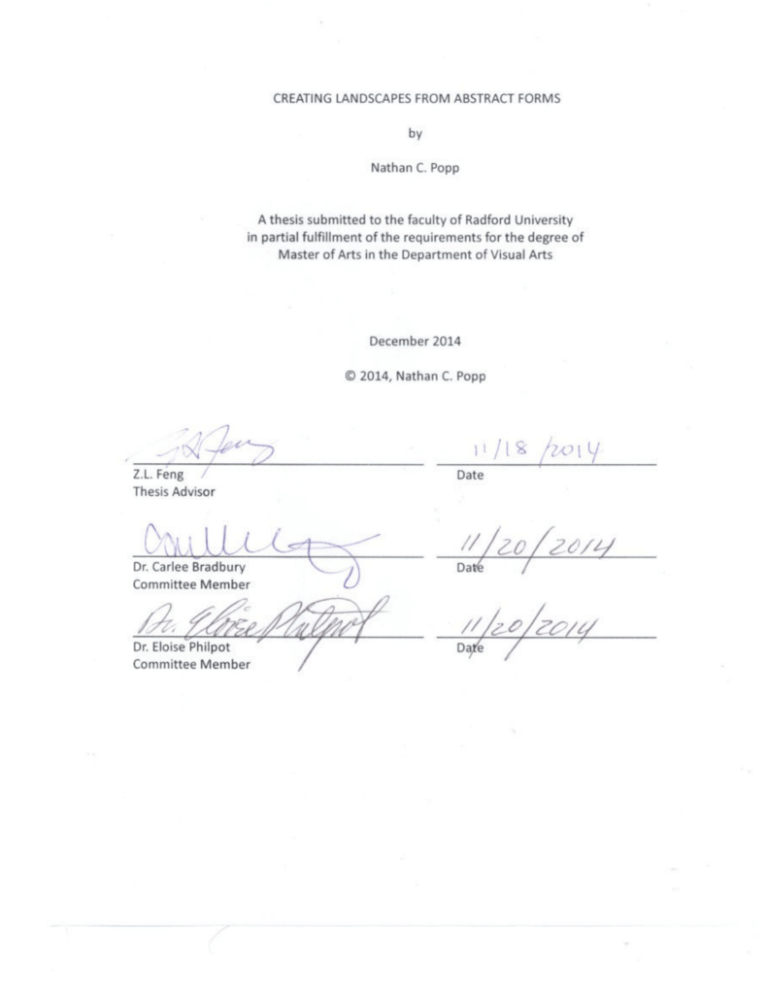
Abstract Nature has an influential role in my art. I am interested in abandoning traditional methods to create mystical landscapes from experimental watercolor techniques and dry media. Using abstract marks to guide me, I create imagery of nature pertaining to the cycle of life: birth, growth, death and rebirth. Nathan C. Popp Department of Visual Arts, 2014 Radford University ii Table of Contents Page Abstract ........................................................................................................................................... ii Table of Contents ........................................................................................................................... iii Table of Figures ............................................................................................................................. iv Chapter 1: Introduction ................................................................................................................... 5 Chapter 2: Methodology ................................................................................................................. 8 Chapter 3: Influences .................................................................................................................... 10 Chapter 4: Conclusion................................................................................................................... 15 List of Terms ................................................................................................................................. 16 Bibliography ................................................................................................................................. 17 iii Table of Figures Figure 1: Nathan Popp. The Fallen, 2014 ....................................................................................... 5 Figure 2: Nathan Popp. Fire Egg, 2014 .......................................................................................... 6 Figure 3: Nathan Popp. Detail of Fertilization, 2014 ..................................................................... 7 Figure 4: Nathan Popp. Thumbnail to Fire Egg, 2014 ................................................................... 8 Figure 5: Pablo Herrero. From the series La Balsa, 2014 ........................................................... 10 Figure 6: Charles Burchfield. Autumnal Fantasy, 1916-1944 ..................................................... 11 Figure 7: Paul Klee. Landscape with Yellow Birds, 1923............................................................ 13 iv Chapter 1: Introduction Landscape painting has ancient roots. Ancient cave paintings, frescoes from ancient Greece and ink wash paintings from China started a long tradition of creating art that reflects the world around us. Throughout art history, landscapes evolved in a variety of forms; from hyper realistic depictions of places to imaginary landscapes that reflect emotional places. When creating a traditional landscape there are basic formulas to follow: having a fore, middle and background to create depth as well as having proportionate scale of the objects that inhabit the space. Many artists need to recreate the world outside, but I am more interested in abandoning these traditions and using experimental techniques that Figure 1: Nathan Popp. The Fallen, 2014 5 create a new style of landscape. Using watercolor marks abstractly, imaginary landscapes are created out of treelike imagery and other objects drawn from nature. This series of work ties imagery into a symbolic reference of the cycle of life: birth, growth, death and rebirth. It also is a reflection of an archetypal subconscious world. Personal emotions are experienced through color and symbolic imagery. Bold color combinations can evoke these emotions in the viewer. For instance, the color green traditionally symbolizes growth, harmony, and fertility. In The Fallen (Figure 1), green represents growth and harmony around a felled tree that is pulling energy from the forest. Red is associated with energy, strength, and power as well as passion, desire, and love. Imagery drawn from nature is used symbolically. Nature represents growth and is symbolized by trees in my work. Along with other symbols, including birds, eggs, nests, and mushrooms, I embody life cycles that we all live. In Fire Egg (Figure 2), birds guard a cosmic egg Figure 2: Nathan Popp. Fire Egg, 2014 6 which symbolizes the initial stage of life and the universe. The absence of the human form is important because nature is pure while the human element adds corruption by polluting the world. Figure 3: Nathan Popp. Detail of Fertilization, 2014 Another symbol of growth can be seen in a dry medium I use. Urea is an organic compound found in fertilizers. When it is added to a wash of watercolor it begins to dissolve and as the wash begins to dry, crystals form on the surface of the paper. This effect is heightened when applied to yupo paper, allowing more urea to crystallize on the surface of the paper, as seen in Figure 3. Tying all these elements together creates a new style of work that reflects me as an artist. 7 Chapter 2: Methodology Figure 4: Nathan Popp. Thumbnail to Fire Egg, 2014 Producing work on a large scale can pose several problems. When committing to creating something on a large piece of watercolor paper it helps to have a clear idea of what one is trying to accomplish; if not, you could ruin an expensive piece of paper. When starting a large piece I generally begin by painting thumbnails on smaller pieces of watercolor paper. Figure 4 shows the initial thumbnail to Fire Egg. This helps me to get an idea of what color scheme will be used and the overall layout of the piece. The nature of how I produce my work makes it impossible to produce an exact replica of the painted thumbnail; I use it to gain a better understanding of what I am trying to create. Once these requisites have been established I can begin working on a larger scale. To achieve the desired scale, the paper is cut from a roll. After the piece of paper is cut it needs to be prepared for painting; the paper is too curled to paint on due to being rolled. First, the paper needs to be wet in order for it to lie flat. Spraying the curled paper with water allows the paper to uncurl and be laid flat on a table. After the paper dries I begin the process of painting. 8 Using the thumbnail as a reference for color and composition I begin the initial layer of watercolor. In this layer most of the pigment of the painting is applied to the paper. Since water is the vehicle in watercolor, wetting the surface of the paper allows the pigment to flow on the paper. This is important because I allow the paint to run naturally, creating uncontrolled blooms of color. Also, I rely on how the different types of paint react with each other; some paints naturally push other pigments into opposite directions. While the initial layer is still wet, I begin to add dry media like salt and urea to the wash. These dry media create texture and interesting watermarks once the first layer has dried. Depending on the amount of water used in the initial layer and the humidity in the air, drying times can vary, especially with yupo paper, since water has to evaporate off the surface. After the initial layer has dried comes an important step in the process; I hang the painting and contemplate the final orientation of the piece. I subconsciously find shapes, line and other forms in the abstract watercolor marks that seem to transform into an imaginary landscape. Leonardo da Vinci wrote about tapping into the subconscious and using it as an artistic tool: If you look at any walls spotted with various stains or with a mixture of different kinds of stones, if you are about to invent some scene you will be able to see in it a resemblance to various different landscapes adorned with mountains, rivers, rocks, trees, plains, wide valleys, and various groups of hills.1 Using these subconscious cues, I plan out how the imaginary landscape created by the watercolor washes, textures and color will contain, and help merge, the symbolic figures. When painting in the trees I use a wet-on-dry technique, meaning I add wet paint onto a dry surface. This allows the trees to have sharp, detailed lines that contrast with the layered spatial transparencies. When adding symbolic imagery, multiple techniques are used depending on the desired effect. I employ lifting techniques and add washes to certain areas to blend into the atmospheric depth. 1 Curdy. Leonardo da Vinci’s Note-books. 173. 9 Chapter 3: Influences As an artist and student, I constantly look at artwork to gain new ideas. Some inspire techniques while others give me subjects that I can reinterpret into personal ideas that relate to my work. Some of my most influential artists for my body of work are Pablo S. Herrero, Charles Burchfield and Paul Klee. I also research ancient symbolic forms to make sense of my own symbolism, the cycle of life. Figure 5: Pablo Herrero. From the series La Balsa, 2014 Contemporary artist Pablo Herrero is a Spanish muralist who is known for his large collaborative street art in Europe and the United States. Recently, he has been experimenting in his studio with inks on paper to create landscapes from abstract forms. Using a limited palette, Herrero uses black ink with one or two different colors. The colors he uses invoke the sense of earth and atmosphere of the environment he creates. There is a limited sense of space in the backgrounds and his trees lack dimension. Using the abstract marks made by the ink drying, Herrero pulls silhouetted trees to create 10 landscapes. One of his current series titled Le Balsa (Figure 5) is comprised of landscapes created from ink blots on paper. Similar to my style, Herrero is relying on his subconscious to find landscapes from abstract marks. Figure 6: Charles Burchfield. Autumnal Fantasy, 1916-1944 11 Another artist who is a major influence to my work is the American-born watercolorist Charles Burchfield. Though Burchfield is known for his cityscapes of Buffalo, NY, it is his ethereal landscapes that inspire me. Considered a loner for most of his life, he took comfort in escaping into the woods. “For Burchfield, nature has always been a mystical experience full of wonders, terrors and true miracles. Every season, every time of day, every change of weather, every flower and insect has its special meaning.”2 Instead of a realistic representation of nature, he takes the elements and brings them together to create a work that seems to be alive. The painting Autumnal Fantasy (Figure 6) exudes the energy that Burchfield felt while in the woods. He paints as if one is looking through a window onto the scene he was experiencing, transferring energy to the viewer. The symbolic meanings behind the naturalistic imagery were not meant to be taken literally. “They are, rather, evocative pictorial elements which he varied, altered and wove together as the mood and design required.”3 This idea of taking this imagery and not trying to use it in a literal sense, but giving it an open symbolic meaning that the viewer mentally constructs, is a basic principal to my work. 2 Baur. Charles Burchfield. 13 3 Baur. Charles Burchfield. 31. 12 Figure 7: Paul Klee. Landscape with Yellow Birds, 1923 In the book Klee, author Daniel-Henry Kahnweiler states that “Klee was considered as a dreamer, disdaining Reason and giving himself up to the liberation of the subconscious.”4 As a watercolorist, my style has been influenced by the works and philosophy of the Swiss-German surrealist Paul Klee. Not being limited to a single medium, Klee’s body of work includes oils, watercolors, gouache, ink and pastel. He also experimented by combining these materials into mixed media pieces. His watercolor and ink paintings inspired my own voice of experimentation. In Klee's Landscape with Yellow Birds (Figure 7), the shallow depth of field, bold color, and simplistic imagery of nature allow viewers to create their own meaning. Abandoning the desire to represent nature as we see it, Klee’s paintings include “memory-images which permit the objective interpretation of the work.”5 These images are not realistic but are representations of known objects that trigger our subconscious understanding of that image. This is what I aim for in my own work. 4 Kahnweiler. Klee. 15. 5 Kahnweiler. Klee. 19. 13 Trying to make sense of the symbolic imagery of the life cycle may be difficult. Having knowledge of ancient beliefs helps decode my work. Life, growth, and death are a constant not only today but also thousands of years ago. I incorporate imagery that deals with idea of the cycle of life. One of these symbols is the primordial or cosmic egg. In Paleolithic hunting and fishing societies the egg represented the creation of life and the universe. This cosmic egg is usually paired with a water bird goddess figure, representing the creator.6 Birds are a common element in my work and are seen in conjunction with egg shapes and nest imagery. Not only are they the creators, they are also the protectors of life. Another popular symbol from ancient hunting and fishing societies is the fish. Having a wide range of meaning, fish can be interpreted as an emblem of the vulva or phallus as well as the “mystic ship of life.”7 The fish is associated with fertility and the seasonal abundance of food. Imagery of mushrooms pops up in unexpected places in my work like rings of fungi after a rain. Keeping within the idea that these symbols were used to represent fertility and the creation of life, the mushroom can be interpreted as a phallic object.8 They are also associated with strength, longevity and immortality. 6 Gimbutas. The Goddesses and Gods of Old Europe. 101. 7 Gimbutas. The Goddesses and Gods of Old Europe. 107. 8 Gimbutas. The Goddesses and Gods of Old Europe. 220. 14 Chapter 4: Conclusion During a lecture, Paul Klee defined an artist as being a mediator; he used a tree as a metaphor: The roots deep in the earth are the guiding principal towards the element of nature and life. The sap rises from the roots and flows through the artist and through his eye. He takes the place of the tree-trunk. Moved and urged by this powerful flow, the artist transmits his vision to his work and his work can be compared with the foliage of the tree, visible from all sides in both time and space.9 As an experimental landscape painter, I find the concept that an artist is like a tree fascinating. I become the subject of my own work. The work I produce is what people see, the foliage of the tree. Like roots pulling nutrients from the soil, my ideas come from the life experiences I have lived and are reflected in my work. As I continue to paint and experience the world, I will grow as an artist by experimenting with techniques and mixed media. 9 Kahnweiler. Klee. 17. 15 List of Terms Blooms- cauliflower-looking marks created when extra moisture creeps back into a damp or partially dry area of a painting. As the excess water levels out it will push the tiny pigments of paint to the outside edge of the watermark. Lifting- a watercolor technique used to remove or soften unwanted applications of paint. Urea- an organic compound that is a byproduct of kidneys in mammals. A synthesized version has many industrial and artistic uses. Vehicle- the medium which carries pigments in suspension, which allows them to be applied to a surface. Wash- diluted watercolor applied to the surface of the paper, creating translucent color. Yupo- a waterproof, tree-free synthetic paper extruded from polypropylene pellets. 16 Bibliography Baur, John I. H. Charles Burchfield. New York: The Macmillan Company. 1956. Curdy, Edward M. C. Leonardo da Vinci’s Note-books: Arranged and Rendered Into English. New York: Kent Press. 2007. Gimbutas, Marija. The Goddesses and Gods of Old Europe: Myths and Cult Images. Los Angeles: University of California Press. 1982. Kahnweiler, Daniel-Henry. Klee. Paris: Braun & Cie. 1950. 17

